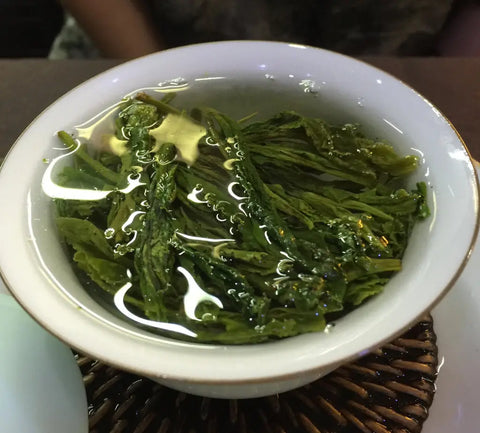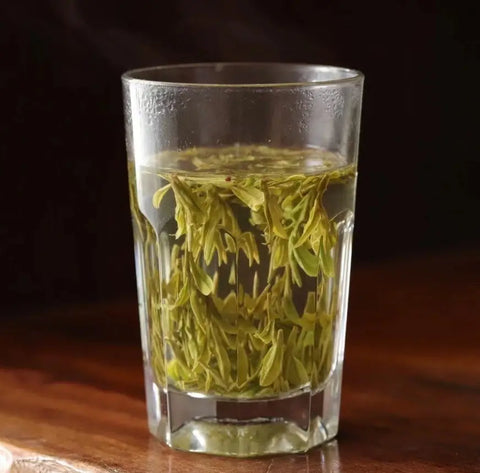
Green Tea Steeping FAQ: How Long You Should Brew, Resteeping, Water Quality and More
In today’s post, we’re going to look closely at some of the most commonly encountered problems and questions tea drinkers have when attempting to brew green tea.
If you’ve ever wondered how long to wait between infusions or what to do when you don’t have a variable temperature control electric kettle, you will find the following FAQ immensely helpful.

Q1. I use a stovetop kettle and thermometer for my teas. Am I supposed to let the water boil first for my green tea? I just don’t have the time to wait that long for it to cool down.
We always recommend that you boil the water first, letting it cool down to 180° F (82°C) before pouring it over your green tea. Of course, the drawback is that you’ll need to wait a moment, but fortunately, there are ways to cool your water down more quickly.
What’s the solution?
For one, take care to ensure that your teaware is made of glass or porcelain, materials that allow heat to escape faster (unlike stoneware, which holds on to the heat). While it may be tempting to put your gaiwan or Yixing teapot to good use, these are not ideal for brewing green tea. Instead, we would recommend investing in something like a glass teapot.
When you’re ready to brew your tea but you’re pressed for time, a technique to cool your water down is to set aside two cups, bowls, or servers, and then transfer the water in and out of each until it reaches the desired temperature.
Q2. How long are you supposed to brew your green tea? I seem to get mixed messages about this from different sources, some claiming 30 seconds, 1 minute, or even as long as 3 minutes. Can you clarify this?
How long you brew your tea depends on the leaf to water ratio, the type of green tea, and your personal preference. Steeping longer, for example, will always result in a stronger flavor, but for some green tea, it will also introduce bitterness.

For your first infusion, we recommend a water temperature around 80–85°C (175–185°F) and an infusion time around 1–2 minutes. The goal is to bring out complexity and nuance while minimizing astringency and bitterness, and much of this depends on the type of tea you’re steeping. For hardier green teas (such as Anji Bai Cha), a steeping time closer to 2 minutes will do the trick, but for more delicate green teas (like Dragonwell), any time longer than 1 minute could result in bitterness.
It is important to remember that things change a little when it comes to subsequent steeps though.
With your second steep, we usually advise shortening the infusion time since the tea leaves are already saturated and opened, unlike the initial infusion (opened leaves will release more flavor into the water more quickly); but with the third steep, you’ll want to do the opposite and increase your infusion time, in some cases even as long as 3 minutes. Because green teas are usually only steeped 2 or 3 times, the 3rd infusion will demand the most patience for extracting any remaining flavor after the first 2 steeps.
It’s important to keep in mind, however, that this only applies to green teas. Oolongs and Pu-erh's, for instance, can be steeped around a dozen times (with high-quality Pu-erh even known to withstand more than twenty infusions).
Q3. I try to measure out my tea, but what is a good tea to water ratio? I’ve seen places suggest 4g of tea to 6oz, 8oz, and even 12oz of water.
It’s important to know how much volume your mugs, teapots, and gaiwans can hold; otherwise, you may be using too much or too little water, both of which can adversely affect the overall taste.
When working with your usual quantities, such as 6–8oz of water, we can make the following recommendation:
- 2g–3g tea leaves: 6–8oz water
If you wish to use more or less water, however, things can begin to get a little tricky. Much of this boils down to trial and error. For instance, you might discover that you can double your total number of infusions with 2g of tea and just 3oz of water, but then that also requires more frequent infusions. Aim to find your balance between convenience, cost, and desire.

Ultimately, the best outcome with your green tea depends on the water to leaf ratio, temperature, infusion time, and water quality. Any amount of tea can be prepared with an appropriate adjustment to the guidelines above. These are tried-and-true ratios that guarantee the best taste for your tea and the most bang for your tea leaves.
Q4. I know that you can resteep your teas, but sometimes my second steeping doesn’t taste quite right. How long can you let your used leaves sit around? How long can you wait between infusions?
To get the most out of your tea, then, you will want to take care not to wait too long between infusions. In a perfect world, you would re-infuse your tea leaves within 5–10 minutes of your previous infusion (like what you find during a Gong Fu Tea Ceremony), but at a minimum, we recommend waiting no longer than 90 minutes between infusions, assuming the leaves are not soaking in water and you’ve completely emptied your teapot or gaiwan.
While there can be some flexibility, depending on your taste preferences, for both health reasons and optimal tasting quality, we certainly wouldn’t recommend using wet leaves that are more than a few hours old.
Q5. I’ve heard that you should leave some water to cover your leaves between infusions. Is this true? What purpose does this serve? Wouldn’t this make your tea too concentrated?
The reason for letting your leaves soak in some water between infusions is to even out the tea flavor over several steepings. To do that, you need only a little bit of water leftover, just enough that it nearly covers the remaining leaves. If you use too much or too little water, you defeat the purpose of this technique.
If you decide to try this method out, however, you will want to take care not to wait too long between infusions. Around 5-10 minutes can be fine (although pushing it), but we cannot recommend letting your leaves steep in a little bit of water any longer than that. If you wait as much as an hour, for example, you’ve created a recipe for terrible tasting tea, introducing astringency, bitterness, and worse to your cup.

Q6. I see on your website and packaging that you recommend we use filtered water and spring water. What’s wrong with distilled water or tap water? Can I still use these?
In many cases, tap water can be laden with too many chemicals that can suppress the fragrance and character of the tea. For example, in some places, there is a very real concern that heavy metals such as lead, nickel, or copper have reached concentrations in the water that are unsafe for long-term consumption. Besides these concerns, there’s also the chlorination and fluoridation treatments used to clean tap water, treatments that sometimes result in a funny taste. While you may get used to this taste, unable to notice it anymore, the very presence of these chemicals still prevents your tea from releasing an optimal amount of flavorful and aromatic compounds into the water, risking an underwhelming cup of tea (and in some cases, even tea that tastes sour, metallic, or salty). This means that even at low concentrations, these chemicals decrease the quality of your cup.
When it comes to distilled water, there’s a different set of issues. This type of water lacks dissolved oxygen and other important minerals that can enhance flavor, such as magnesium, zinc, and potassium. The oxygen is what gives your water a liveliness while the minerals impart a taste. Distilled water, in contrast, is flat and bland, and these same qualities carry over to the tea you make with it, resulting in a flat and bland cup.
Per our experience, spring water guarantees the best results. Of course, you’ll need to experiment a little to discover which brand is best for your tea. Since each brand has a different combination of minerals in the water, each will affect the outcome of your cup a little differently.
We hope you’ve enjoyed this Green Tea FAQ, and if you have any other questions, please feel free to post them below!
